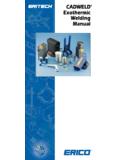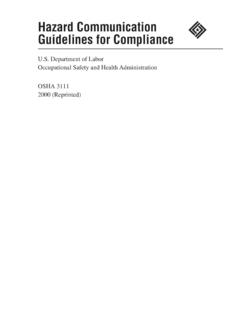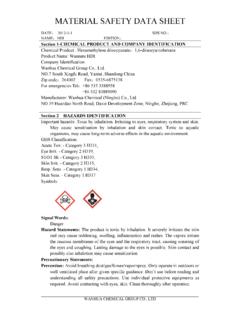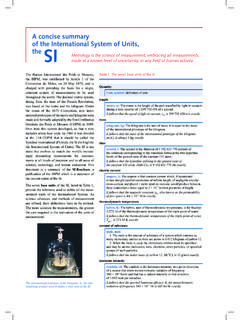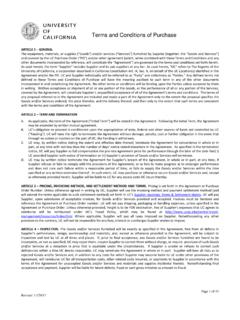Transcription of Consolidated Study Material P-98 - New York City
1 FIRE DEPARTMENT city OF NEW york Study Material CERTIFICATE OF FITNESS FOR SUPERVISE FUEL-OIL PIPING AND STORAGE IN BUILDINGS P-98 ALSO INCLUDED IN THIS BOOKLET YOU WILL FIND THE FOLLOWING: NOTICE OF EXAMINATION (NOE) 2008 New york city Fire Department - All rights reserved P-98 Study 06/2008 2 NOTICE OF EXAMINATION FOR Title: Consolidated Examination for the Certificate of Fitness for city Wide Fuel-Oil Piping and Storage System (P 98- W98) Date of Test: Written tests are conducted Monday to Friday (except legal holidays) 9:00 AM to 2:30 PM. QUALIFICATION REQUIREMENTS 1. Applicants must be at least 18 years of age.
2 2. Applicants must have a reasonable understanding of the English language. 3. Applicants must present a letter of recommendation from his/her employer, trade school or trade union. The letter must be on official letterhead and must state the applicant s full name, character, physical condition, experience, and address of premises where applicant will be employed. Self-employed applicants must submit a notarized letter. 4. Applicants must present two (2) forms of satisfactory picture identification , driver s license and passport ID pictures. APPLICATION INFORMATION Application Fees: $ for originals and $ for renewals. The fee may be paid in cash, money order, or personal check payable to New york city Fire Department.
3 The $ fee must be payable by all applicants prior to taking the Certificate of Fitness test. Application forms are available at the Public Certification Unit, 1st floor, 9 MetroTech Center, Brooklyn, NY 11201. TEST INFORMATION Test: The test will be of the written, multiple choice type. A passing score of at least 70% is required in order to obtain a Certificate of Fitness. Individuals holding a Certificate of Competence as a Boiler Inspector from the NYS Dept. of Labor; or a license as a High Pressure Boiler Operating Engineer or a license as an Oil Burning Equipment Installer from the NYC Dept. of Buildings may have the written test waived and receive a COF via the Alternative Issuance Policy.
4 Call (718) 999-2482 for additional information and forms. 2008 New york city Fire Department All rights reserved Consolidated P-98 050200 3 This Study Material contains some of the information you will need to prepare for the Consolidated examination for the certificate of Fitness for Supervision of Fuel Oil Piping And Storage System (P98). The Study Material includes information taken, for the most part, from relevant sections of the Building Code of New york . Other information describes the proper operation and maintenance of Fuel oil piping and storage systems. All questions on the Certificate of Fitness examination are multiple choice, with four alternative answers to each question.
5 Only one answer is correct for each question. If you do not answer a question or if you mark more than one alternative your answer will be scored as incorrect. A score of 70% correct is required on the examination in order to qualify for the Certificate of Fitness. Read each question carefully before marking your answer. There is no penalty for guessing. Sample Questions _____1. What is the capital of the United States? (A) Washington (B) Albany (C) Trenton (D) Providence The correct answer is A . You would press A on your touch-screen monitor. _____2. The United Nations building is located in: (A) Queens. (B) Manhattan. (C) Washington . (D) Los Angeles.
6 The correct answer is B . You would mark B on your touch-screen monitor. 4 OIL BURNER OPERATION Combustion is the chemical union of the oxygen in the air with combustible elements in the fuel-oil (hydrogen and carbon). The end result of this process is the production of heat energy. Oil firing equipment is used to liberate heat energy from the fuel-oil. Oil burners are the principal components of the oil firing equipment and provide the means of supporting the process of combustion. Carbon and hydrogen are the two principal elements of fuel oil. During the combustion process, the carbon content of the fuel-oil (about 85%) unites with the oxygen in the air and forms carbon dioxide and carbon monoxide.
7 The hydrogen content of the oil (about 14%) unites with the oxygen and produces water. The objective is to have a complete combustion process. This objective is met when the fuel-oil combines with the greatest possible amount of oxygen. Oil is a liquid fuel and as such will not burn. It must be changed to a gas or vapor and mixed with air in order to support combustion. The oil burner is primarily a device for processing the liquid fuel for combustion by accelerating the change from liquid to a vapor that can be mixed with air and burned. This process of breaking down or atomizing the oil is necessary to ensure prompt ignition and rapid combustion.
8 Although there are various types of oil burners, generator or boiler, they all vaporize or atomize the oil before it enters the combustion chamber where it is mixed with air in predetermined proportions. The oil burner uses an oil pump and mixes air and oil within the nozzle itself. In oil burners, the oil and air mixture is delivered to the nozzle at a pressure dependent upon the make of the burner. The air that contacts the oil prior to its leaving the nozzle is referred to as primary air. The introduction of air from the blower or fan into the combustion chamber after the oil has left the nozzle is referred to as secondary air. Every brand of oil burner is essentially unique and different from that of other manufacturers.
9 Diesel generators use injection nozzles without primary air Thus it is important that an operator of a system understand the functions of his/her particular system completely Oil burners require approximately 2000 cubic feet of air per gallon of oil consumed. The mixture of oil and air is sprayed in vapor form into a firebox area (the combustion chamber) where combustion takes place. The mixture of air and fuel in the burner must be strictly controlled. Poor mixture could become an explosive mixture. During the process of combustion, one part of carbon unites with two parts of oxygen to produce carbon dioxide (CO2).
10 Each time one pound of carbon is burned, 14,544 BTU of heat are liberated. Carbon dioxide is recognized as the end product of complete combustion. Should the fuel be supplied without the proper amount of oxygen, then carbon dioxide and soot will be produced It will be produced at 4,480 BTU at heat liberated. Carbon monoxide is recognized as the end product of incomplete combustion. In addition to being inefficient in the production of heat, the presence of carbon monoxide is highly dangerous. If the proper amount of air has been thoroughly mixed with the oil, and the temperature of the flame is correct, the free carbon burns completely.











